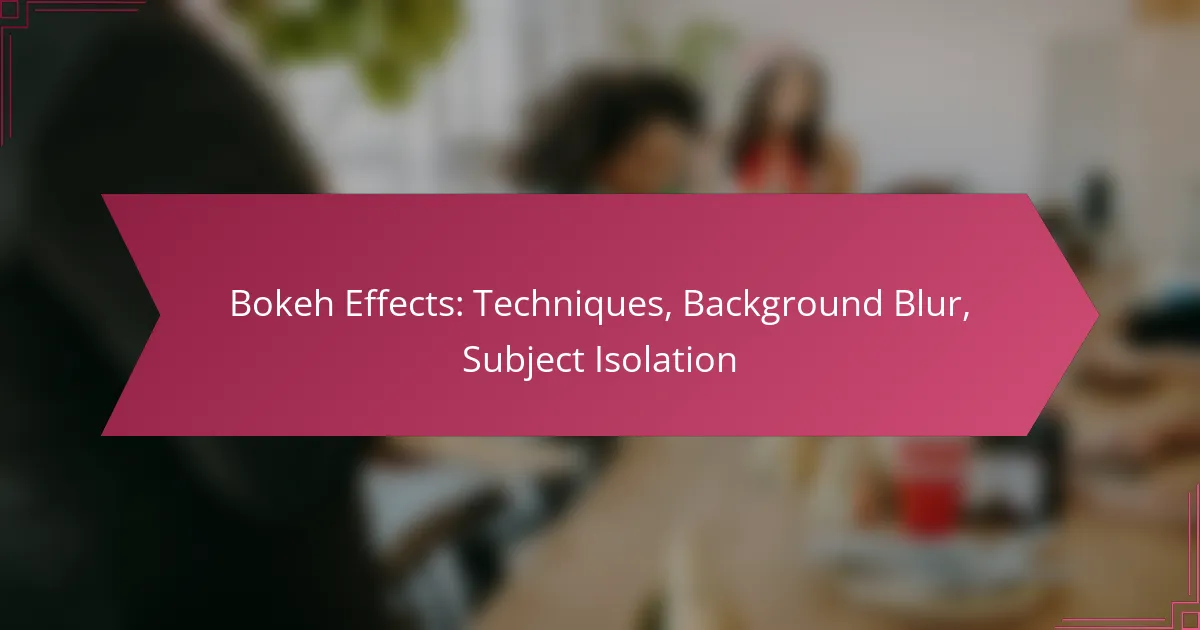Bokeh effects in photography are essential for creating a visually striking separation between the subject and its background. By employing specific techniques to manipulate depth of field and lens characteristics, photographers can achieve a pleasing blur that enhances subject isolation and minimizes distractions. This results in images where the main focus is accentuated, drawing the viewer’s attention effectively.
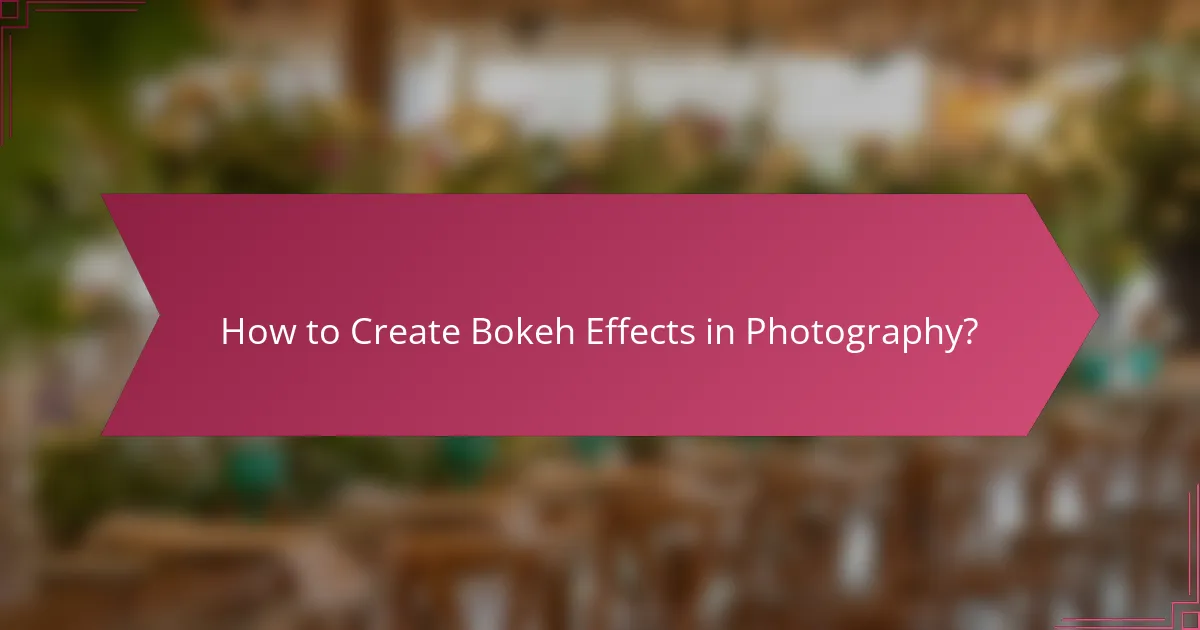
How to Create Bokeh Effects in Photography?
Bokeh effects in photography are achieved by using specific techniques that emphasize the subject while blurring the background. This creates a visually appealing separation that draws attention to the main focus of the image.
Use a wide aperture
Using a wide aperture, such as f/1.8 or f/2.8, is essential for creating pronounced bokeh effects. The larger the aperture, the shallower the depth of field, which results in a more blurred background. This technique allows for a smooth transition between the sharp subject and the out-of-focus elements.
However, be mindful of the trade-off: a wide aperture can make it challenging to keep multiple subjects in focus. It’s best suited for portraits or single subjects where isolation is desired.
Choose the right lens
Selecting the appropriate lens can significantly impact the quality of bokeh. Prime lenses, particularly those with longer focal lengths like 85mm or 135mm, often produce smoother bokeh compared to zoom lenses. Look for lenses with rounded aperture blades, as they create more aesthetically pleasing out-of-focus highlights.
Additionally, consider the lens’s maximum aperture; wider apertures yield better bokeh. Experimenting with different lenses can help you find the one that best suits your style.
Adjust distance from subject
The distance between your camera, the subject, and the background plays a crucial role in achieving bokeh. Positioning your subject closer to the camera while keeping the background further away enhances the blur effect. This separation increases the contrast between the sharp subject and the out-of-focus background.
As a rule of thumb, try to maintain a distance of at least a few feet between the subject and the background. This will help create a more dramatic bokeh effect.
Utilize background elements
Incorporating interesting background elements can enhance the bokeh effect. Look for lights, colors, or textures that can create visually appealing shapes when blurred. For instance, streetlights or holiday lights can turn into beautiful orbs of color in the background.
Be intentional about your background choices. Cluttered or distracting elements can detract from the subject, so aim for backgrounds that complement rather than compete with your main focus.
Experiment with lighting
Lighting conditions can dramatically affect bokeh quality. Natural light during golden hour often yields soft, pleasing bokeh, while harsh midday sun may create less desirable effects. Consider using backlighting to enhance the bokeh, as it can create a glow around the subject.
Additionally, using artificial light sources, like fairy lights or LED panels, can add depth and interest to your bokeh. Experimenting with different lighting setups will help you discover what works best for your photography style.
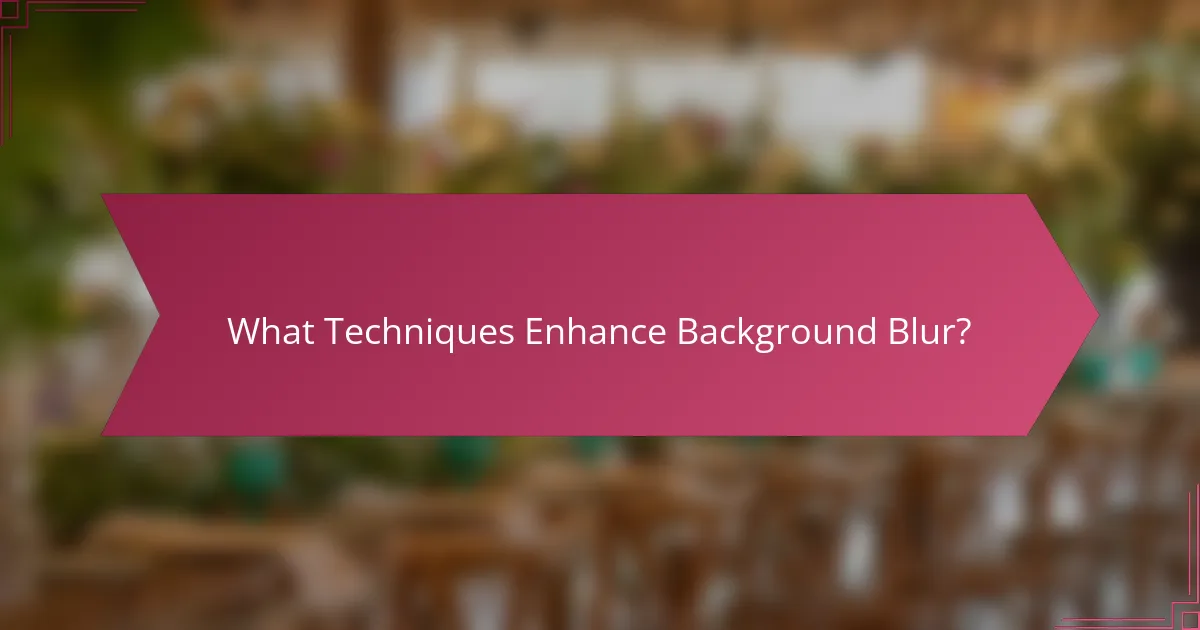
What Techniques Enhance Background Blur?
To enhance background blur, photographers often use specific techniques that manipulate depth of field, lens characteristics, and focal length. These methods help isolate the subject and create a pleasing bokeh effect, making the main subject stand out against a soft, blurred background.
Utilize shallow depth of field
A shallow depth of field is achieved by using a wide aperture, typically ranging from f/1.2 to f/4, which allows only a narrow plane of focus. This technique effectively blurs the background while keeping the subject sharp, creating a striking contrast. When shooting portraits or macro photography, a shallow depth of field can significantly enhance the visual appeal.
However, be cautious with your focus point, as a very shallow depth can lead to missed focus on the subject. Always ensure that your subject is well within the focal plane to avoid unintentional blur.
Incorporate lens filters
Using lens filters, such as a circular polarizer or a neutral density (ND) filter, can enhance the bokeh effect by controlling light and reflections. ND filters, in particular, allow for wider apertures in bright conditions, enabling a shallower depth of field without overexposing the image. This can be particularly useful in outdoor settings where light is abundant.
When selecting filters, ensure they are of high quality to avoid degrading image quality. Additionally, consider the filter’s effect on color balance and contrast, as these factors can influence the overall look of your photograph.
Adjust focal length
Changing the focal length of your lens can greatly affect the background blur. Longer focal lengths, such as 85mm or 135mm, naturally compress the background and enhance the blur effect, making them ideal for portrait photography. Conversely, shorter focal lengths may require closer proximity to the subject to achieve a similar effect.
Keep in mind that using a longer focal length may require more space to frame your subject effectively. Experimenting with different focal lengths can help you find the right balance between subject isolation and composition.
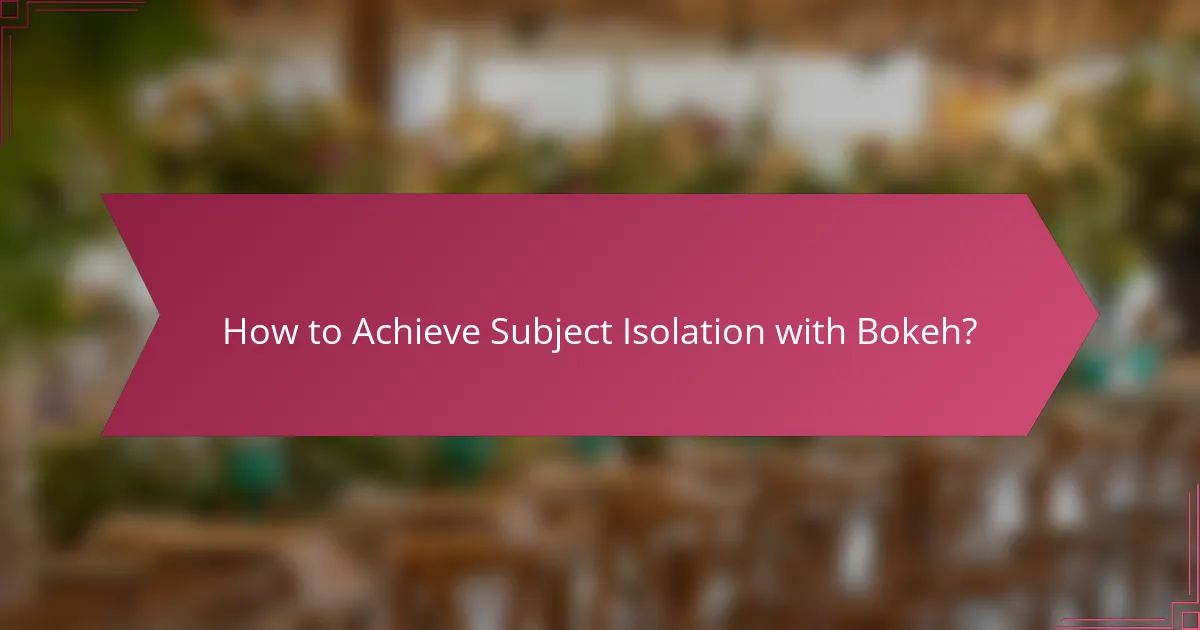
How to Achieve Subject Isolation with Bokeh?
Subject isolation with bokeh can be achieved by manipulating depth of field to create a pleasing background blur that emphasizes the main subject. This technique enhances the visual impact of the subject by reducing distractions and drawing the viewer’s attention directly to it.
Position subject away from background
To effectively isolate your subject, position it at a greater distance from the background. This separation increases the blur effect, making the background less recognizable and more aesthetically pleasing. A distance of at least a few feet can significantly enhance the bokeh effect.
Experiment with various distances to see how it affects the overall composition. The greater the distance between the subject and the background, the more pronounced the bokeh will be.
Use longer focal lengths
Using a longer focal length lens, such as an 85mm or 135mm, can greatly enhance subject isolation. Longer focal lengths compress the scene and create a shallower depth of field, which accentuates the bokeh effect. This is particularly effective for portrait photography.
Keep in mind that longer lenses may require more space to work effectively, so plan your shooting environment accordingly. Additionally, using a wide aperture, like f/1.8 or f/2.8, will further enhance the background blur.
Control background distractions
Minimize background distractions by choosing simple, uncluttered settings. Look for backgrounds that are uniform in color or texture, as these will contribute to a smoother bokeh effect. Natural settings, such as blurred foliage or soft skies, often work well.
When possible, avoid busy patterns or bright colors in the background that can draw attention away from the subject. If you cannot change the background, consider using a wider aperture to blur it more effectively.

What Equipment Is Best for Bokeh Effects?
To achieve stunning bokeh effects, using the right equipment is essential. Prime lenses, fast zoom lenses, and macro lenses are among the best choices for creating beautiful background blur and isolating your subject.
Prime lenses
Prime lenses are fixed focal length lenses that often have wider apertures, making them ideal for producing bokeh. With apertures typically ranging from f/1.2 to f/2.8, they allow for significant background blur while maintaining sharpness on the subject.
When selecting a prime lens, consider the focal length. Lenses between 35mm and 85mm are popular for portrait photography, as they provide flattering perspectives and excellent subject isolation. Look for lenses with high-quality glass to enhance the bokeh quality.
Fast zoom lenses
Fast zoom lenses offer versatility while still enabling good bokeh effects. These lenses usually have maximum apertures of f/2.8 or wider, allowing for decent background separation. They are particularly useful for photographers who need to quickly adjust their framing without changing lenses.
When choosing a fast zoom lens, opt for one with a constant aperture throughout the zoom range. This ensures consistent bokeh quality, especially when zooming in or out. Popular options include 24-70mm and 70-200mm lenses, which are widely used in various photography genres.
Macro lenses
Macro lenses are designed for close-up photography and can create stunning bokeh effects due to their ability to focus on small subjects. They typically have wide apertures, allowing for beautiful background blur while capturing intricate details.
When using a macro lens, keep in mind that the closer you get to your subject, the more pronounced the bokeh will be. Look for macro lenses with focal lengths around 90mm to 105mm, as they provide a good working distance and excellent image quality.
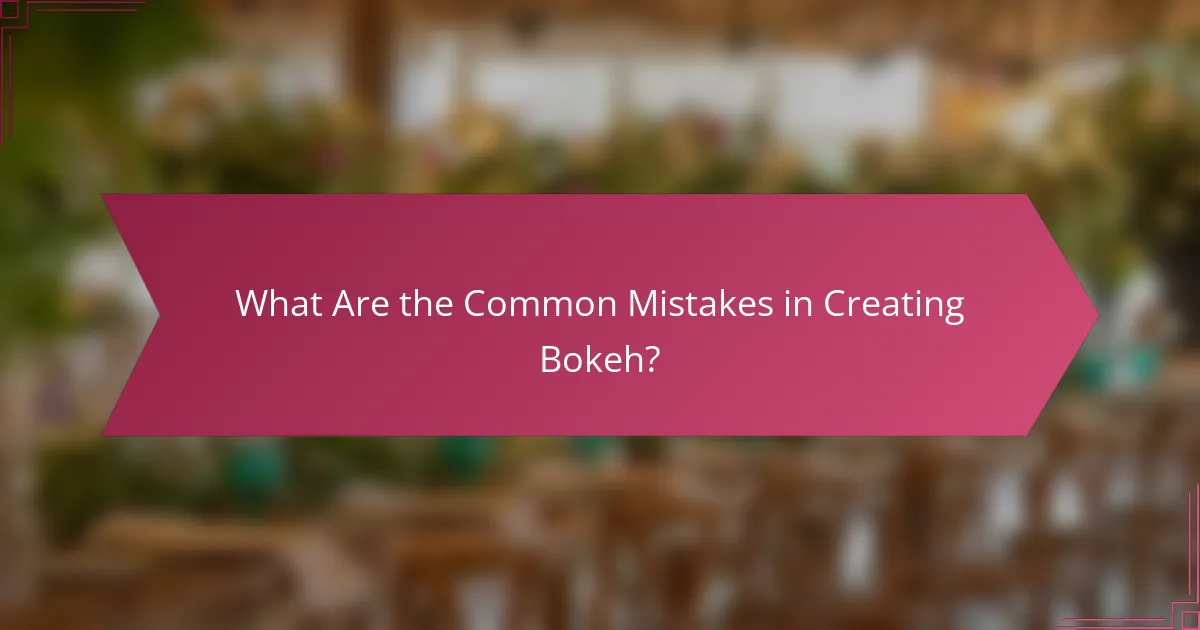
What Are the Common Mistakes in Creating Bokeh?
Common mistakes in creating bokeh include using too small an aperture, neglecting background selection, and ignoring lighting conditions. These errors can lead to undesirable effects that detract from the intended aesthetic of your photographs.
Using too small an aperture
Using a small aperture, such as f/16 or smaller, can significantly reduce the quality of bokeh. This is because a smaller aperture increases depth of field, making more of the background in focus and diminishing the characteristic blur that defines bokeh.
For optimal bokeh, consider using a wider aperture, typically in the range of f/1.4 to f/2.8. This allows for a shallow depth of field, enhancing subject isolation and creating a pleasing background blur.
Neglecting background selection
The background plays a crucial role in achieving beautiful bokeh. Busy or distracting backgrounds can interfere with the soft blur effect, making it hard to isolate the subject. Always evaluate the background before shooting.
To improve bokeh, look for backgrounds with soft colors or patterns that complement your subject. Natural settings, such as foliage or water, often provide ideal conditions for creating smooth bokeh.
Ignoring lighting conditions
Lighting conditions can greatly affect the quality of bokeh. Harsh lighting can create unwanted highlights and shadows in the background, detracting from the overall effect. Soft, diffused light is generally more favorable for achieving a pleasing bokeh.
When shooting outdoors, consider the golden hour—shortly after sunrise or before sunset—for softer light. Indoors, using diffusers or reflectors can help create the ideal lighting conditions for bokeh photography.
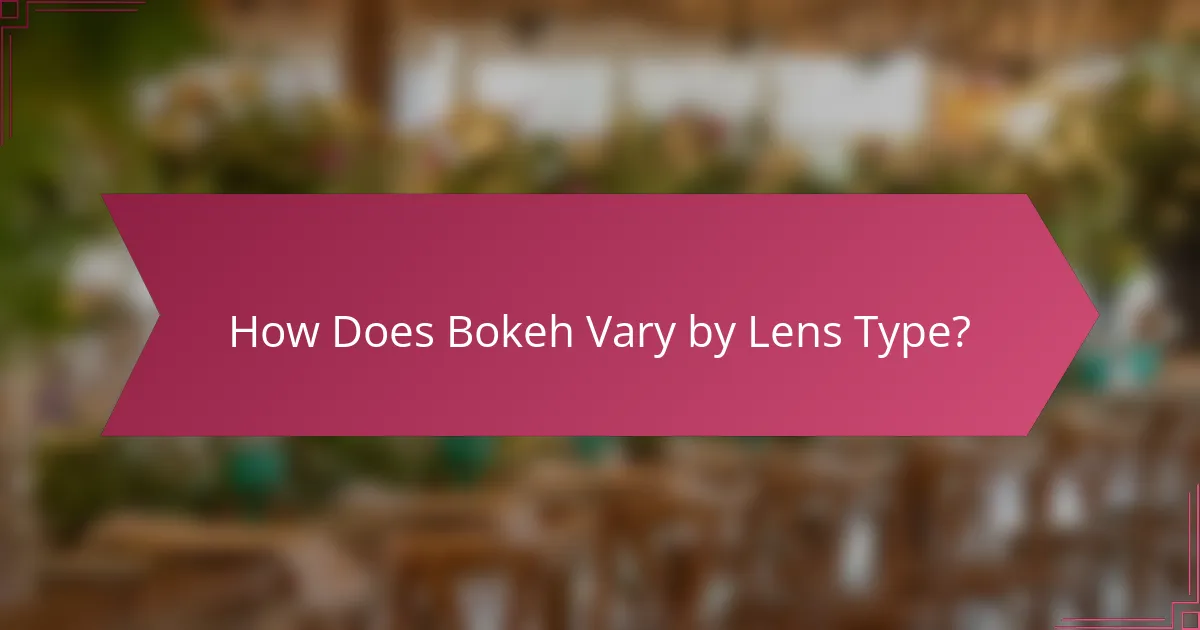
How Does Bokeh Vary by Lens Type?
Bokeh varies significantly by lens type, affecting the quality and appearance of background blur in photographs. Different lenses produce distinct bokeh characteristics based on their optical design, aperture shape, and focal length.
Prime Lenses
Prime lenses are known for their superior optical quality and often produce smoother bokeh compared to zoom lenses. With a fixed focal length, they typically have wider maximum apertures, allowing for more light and a shallower depth of field, which enhances subject isolation.
When using a prime lens, consider the aperture setting; wider openings (like f/1.4 or f/1.8) create a more pronounced bokeh effect. This is ideal for portrait photography, where you want the subject to stand out against a beautifully blurred background.
Zoom Lenses
Zoom lenses offer versatility but may not achieve the same bokeh quality as prime lenses. Their design often includes more elements, which can affect the smoothness of the blur. However, many modern zooms are engineered to provide acceptable bokeh, especially at longer focal lengths.
To maximize bokeh with a zoom lens, use the longest focal length and the widest aperture available. For example, a 70-200mm lens at f/2.8 can produce pleasing background blur, making it suitable for wildlife or event photography.
Macro Lenses
Macro lenses are designed for close-up photography and can create unique bokeh effects due to their ability to focus on small subjects. The close proximity to the subject allows for extreme background blur, enhancing the artistic quality of the image.
When shooting with a macro lens, experiment with different aperture settings to see how they affect bokeh. A wider aperture will yield a softer background, which is particularly effective in nature photography, where you want to isolate intricate details.
Specialty Lenses
Specialty lenses, such as tilt-shift or lensbaby, can produce distinctive bokeh effects that are not achievable with standard lenses. These lenses allow for creative control over focus and perspective, resulting in unique images with artistic blur.
Using specialty lenses requires practice to master their effects. For instance, a tilt-shift lens can create miniature-like scenes with selective focus, while a lensbaby can produce swirly bokeh, making it popular for creative portraiture.
